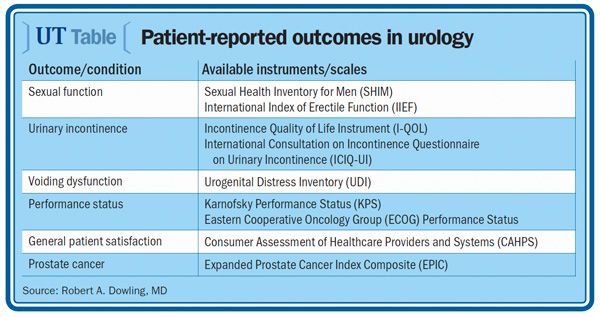Article
What can patient-reported outcomes do for you?
One way to structure health care information that you've accumulated in your electronic health record is to use standard instruments to measure the patient experience-often called patient-reported outcomes.

As we enter the brave new world of data-driven health care and decisions, urologists are beginning to see the value-and limitations-of the clinical data they have accumulated in their practices. The electronic health record contains information needed to support a complex billing and reimbursement landscape; discrete, structured data about conditions, medications, and treatments; and a large amount of unstructured data like narratives that tell the patient’s story and document the clinician’s decision making. All of this information needs to be available for analysis if data will drive health care going forward. One way to structure health care information is to use standard instruments to measure the patient experience-often called patient-reported outcomes.
Patient-reported outcomes (PROs) are, by definition, reported by patients and-in the purest sense of the definition-are not subject to interpretation by anyone else, including physicians. The concept of collecting information from a patient in a standard way may have been born in clinical research in humans, and the FDA continues to give guidance to industry on the use of PROs to support labeling claims (http://www.fda.gov/downloads/Drugs/Guidances/UCM193282.pdf).
PROs can measure symptoms, health, quality of life, patient satisfaction, ratings of health care, social habits, physical or behavioral function, mobility, and other domains of patient perceptions. PROs have long been part of clinical research and trial design, and the demand for improving the health of patients and populations has fueled the measurement of quality.
PROs have formed and will continue to form the basis of many clinical quality measures. PROs can be used in quality measures because they are standardized. They can theoretically be used to normalize measurement across health care providers, settings, time, and interventions; that is, compare apples to apples. An illustrative example of PROs can be found on the Patient Reported Outcomes Measurement Information System (PROMIS) website administered by the National Institutes of Health (http://www.nihpromis.org/Measures/availableinstruments).
Documentation presents a challenge
While it is second nature for urologists to listen to and document the experiences of their patients, no two physicians are likely to document in a standard way that enables accurate analysis of the information. EHRs today address this challenge with templates to facilitate data capture, but the solution is imperfect: The templates can often be customized, the urologist may choose to fill in part or none of the template, or the template may render extraneous output that discourages its use.
PROs address the challenge by forcing the collection of complete and standard information. A PRO instrument familiar to all urologists is the International Prostate Symptom Score (IPSS, also known as AUA Symptom Index), and many practices have the patient fill out a paper version of the IPSS during their office visit intake, as appropriate to their reason for visit.
How does the information actually land in the EHR? If the paper form is merely scanned in, then today’s technologies do not allow the information to be transformed into useful data (values). If the urologist simply narrates the result in the EHR, the data are not easily stored or interpreted.

A better solution is to transcribe the PRO into a template or other electronic form that captures the information as discrete coded data elements-the individual answers and calculated score of the PRO. The ideal solution is to have the patient fill out the electronic form directly through a solution like a patient portal and, after review by an appropriate person, pass it to the EHR. This solution improves practice efficiency and removes any bias that might be inserted by others during collection or recording of the information.
There are several other PROs that urologists should consider incorporating into their practice and that information system vendors should consider including in their offerings. As shown in the table below, these include assessments of sexual health, urinary incontinence, voiding dysfunction, and prostate cancer outcomes, among others.
Barriers to adoption exist
Barriers to adoption of these helpful instruments into common clinical practice include time (the EPIC score may involve dozens of questions) and a lack of consensus about the preferred instrument when several are available. Guidance from thought leaders in urology is needed to address these challenges.
Bottom line: Patient-reported outcomes are one solution to standardizing the collection of relevant health care information and can help form the foundation of measuring outcomes and quality. As specialty standards are developed and EHR systems improve, urologists can incorporate PROs into their daily practice and the value of the clinical data will increase. We will then be one step closer to the promise of data-enabled health care.UT
Subscribe to Urology Times to get monthly news from the leading news source for urologists.

















